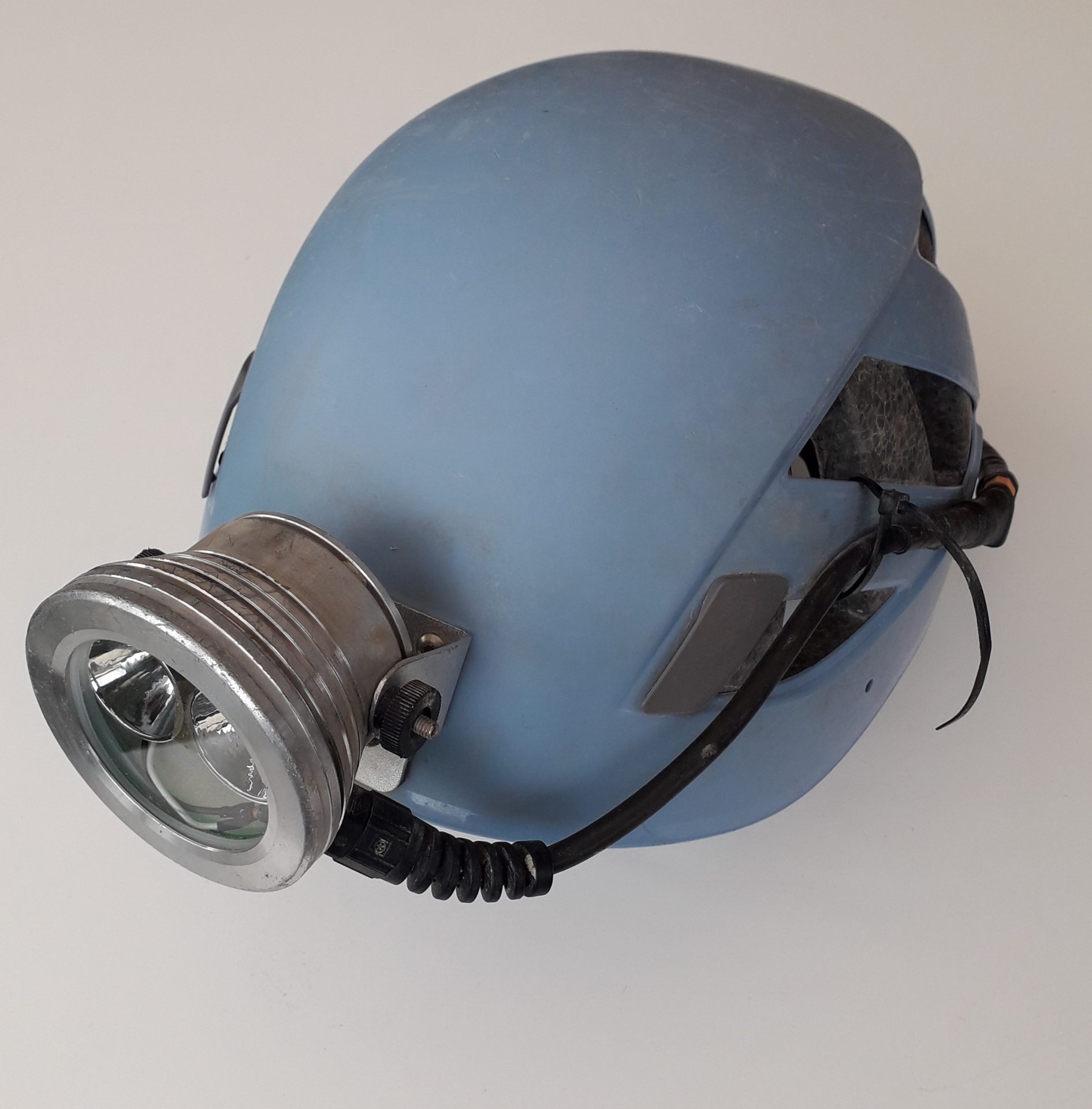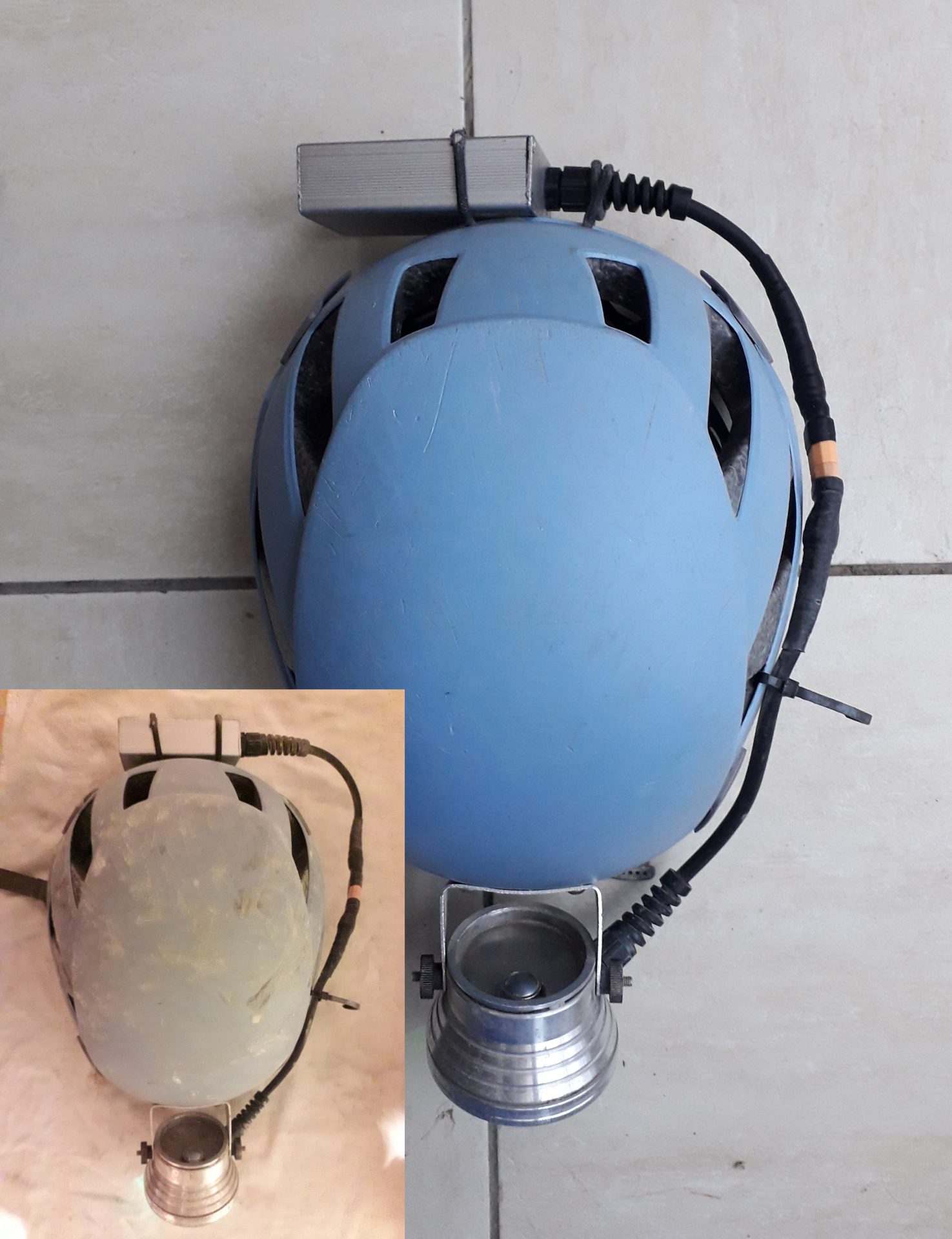
Peter Burgess’ trusty old Petzl Duo lamp finally gave up the ghost after 15 years. He reports back on its replacement – the Lynx X Basic.
Before we start, please bear in mind that I am not a lamp expert, and have only a modest understanding of lighting technology now that lamps no longer consist of a thin wire with lots of electrons running through it to warm it up and make it glow. So, this is a story of how I realised I needed a new lamp, and the choice I made, and some practical information about the lamp I purchased. It is, perhaps, not so much a review of some equipment, but my personal observations on a lamp that I am glad I bought, and which I hope will serve me well for several years to come.
About 15 years ago, I bought my first LED caving lamp, which was a 14-LED array Petzl Duo. This was the first lamp which did not require me to carry its battery attached to a caving belt, forever snagging on things or sliding into awkward places while negotiating tight crawls. I recall that at the time, it was this aspect of the lamp which felt more revolutionary than the novel lighting technology. My Duo proved to be so reliable that it was only in 2018 that I finally got around to replacing it with something more up to date.
During those years that I used my Duo, with almost no problems barring a cable fault a couple of years ago, technology moved on in leaps and bounds. LED lamps evolved from multiple LED arrays to ultra-bright single emitters, but seemed to acquire unaffordable price tags, depending on how bright the lamp was. I had a lamp that worked, that was reliable, and required almost no maintenance. It was quite dim in comparison with other cavers’ lamps, but I have never really been keen on one-upmanship, especially when it involves spending a not insignificant amount of money.
Eventually, however, the time came when I decided that a new lamp was overdue, probably triggered by the above-mentioned cable fault which I had corrected by shortening it and reconnecting inside the lamp. I felt that this was very much a once-only repair, as there was no extra cable left to play with should it happen again, and there was no guarantee that my soldering was going to stand the test of time.
One of my colleagues mentioned to me that Roy Fellows, well-known in mine exploration circles for securing legitimate access to abandoned mines in Wales, was building and supplying a new affordable lamp that I should consider. It came in at £100 including delivery, and seemed remarkably good value for money, considering that my first caving lamp, bought back in the late 1970s, was a bulky lead-acid battery miners’ lamp and set me back in excess of £60. I was aware that Roy has a reputation for providing good lamps, and having learnt that he was now offering a ‘budget’ lamp, I was interested.
The Lynx X Basic, the lamp I was thinking of buying, consists of a sturdy aluminium headset mounted on a light bracket, and powered by a lithium ion battery sealed in an aluminium box. Like the Duo, the battery is designed to sit at the back of your helmet and is connected to the lamp by a stout cable. The cable is in two halves, and charging is performed by disconnecting the battery half of the system, and plugging the charger (supplied with the lamp) into the battery set.
The lamp comes with an alloy bracket and fixing bolts to mount on the front of a caving helmet, and lengths of shock cord to hold the battery in place at the back of the helmet. A set of easy to follow instructions for setting it up is also provided.
Roy has a reputation for supplying lamps with a multitude of functions, flood illumination, spot illumination, varying degrees of brightness, and so on. In the case of the Lynx X Basic, functions are limited to three ranges of settings – one range provides three levels of brightness, a second provides ten levels, and a third range has the thing flashing like a Belisha beacon! The functionality is controlled by holding the power button for different amounts of time.
In practice, I find the basic three levels mode perfectly adequate, and perhaps because I have caved for so long using quite modest levels of illumination, the lowest of the three lighting levels is perfect for almost all scenarios. Even that provides far more light than I have ever enjoyed, starting with my original Oldham right through to my Petzl Duo with its ‘Duo Conversion’ fitted for its spotlight capability.

The lamp also has an interesting traffic light system to indicate the battery charge level. Within the headset is a coloured LED which, as long as the lamp is connected to the battery, shows green if the battery charge is healthy, yellow if partly discharged, and red when the charge level is low. If the red indicator flashes, then it really is time to charge up! There are two main LED emitters with separate reflectors in the headset, angled in slightly different directions, to illuminate both the ground immediately ahead, and the further distance. To a significant degree, this reduces the ‘tunnel vision’ effect of only having one reflector in play.

The power button is at the back of the headset, and is a simple press and release to turn on, and repeat to change brightness level. Holding the button in for a short while determines the mode you wish to use, whether using three levels of brightness, ten levels, or flashing. Simply pressing and releasing quickly cycles through the brightness levels. Turning off is achieved by holding the button in until the light switches off. It’s not easy to describe, but it’s something that is much simpler to understand when you try it.

So, how have things worked out after a year of regular use? I am pleased with the lamp, and despite a few issues, would have no problem recommending it as good value for money. Three significant issues needed addressing, all of which have been resolved quickly and without any problems.
The first problem I encountered was when using a rather muddy glove to operate the switch. Grit entered the small crevice around the edge of the button, and jammed the switch pressed in. This resulted in the lamp going into an uncontrollable cycle of the various modes, and the only way to stop it was to disconnect the battery. Fortunately, this happened on emerging from a cave, so it did not affect my caving trip. It’s one more reason why carrying a good backup lamp is so important. Careful washing and flushing the switch area with clean water resolved the issue quite quickly. Others had reported the same problem, and Roy is now using a better switch on headset units.
I have not asked for the switch to be replaced, and being aware of the problem, it is now just a case of remembering never to use a muddy finger to operate the switch, and the problem has not recurred since. It is also worth remembering that on a normal caving trip of a few hours, the battery is more than adequate to last a busy caving weekend, since we are no longer living in a time when you’d be lucky to get more than two caving trips out of a lamp charge. Switching one’s lamp off to save charge is still something older cavers will habitually do, I suppose!
The second issue was the inadequacy of the thin built-in wire that comes with the little charger. This developed a break in the copper core, which meant that charging became unreliable. A friend had experienced the same problem. Roy was quick to send me a replacement, and again, being aware of the issue means that one takes a bit more care to look after the charger and its cable, and the problem has not recurred.
The third issue was also a cable fault, but this time it was in the feed from the battery to the headset. I contacted Roy immediately, and returned the item for repair. It was back, fully repaired, within a day or so. This one was a bit strange. Roy always cautions against fixing the lamp and battery in such a way that undue strain is placed on either of the two cable entry points (to the headset and to the battery box). I had been careful to follow this advice, but Roy had investigated and found the cable break was a long way from either point of entry, and we were at a bit of a loss to explain the problem.

There was one possible explanation – the cable length. As supplied, and with the headset and battery fitted to my helmet, there was a considerable loop of spare cable. Initially, I tied this with some difficulty to the helmet, but later allowed the cable some freedom which made it easier to charge and put less strain on the wiring. However, this led to the cable being caught on a few occasions when negotiating tight places or simply walking through undergrowth. Twice the cable connector parted. The break in the cable was at a spot where this occasional snagging might have caused the copper core to sever. When arranging for a repair, I asked Roy to make the replacement cable 5cm shorter, so that it would lie much close to the helmet and greatly reduce the chance of snagging.
The Lynx X Basic has proved to be a good lamp, and the service I have received from Roy has been exemplary: swift, courteous and unquestioning. Feedback from myself and from others has been taken on board and modifications built into the design. The Lynx X Basic has now been replaced by an updated model, the Lynx X Basic 2. The new model has a mud-resistant IP 68 switch, slightly improved LED emitters, and instead of two broad beam reflectors, the new model uses one tight spot and one wide-angle version. The improvements have understandably pushed the price up but only slightly, to £100 plus £5 UK delivery.
The Lynx X Basic 2 is sold as IP67 waterproof, but is not suitable for diving. In terms of light output, the Lynx X Basic is the best I have used, and it easily provides enough light for normal caving and mine-exploring. The few issues I have experienced have been more than made up for by the excellent after-sales service. It might seem a little late to review a lamp that is no longer being sold, but I can be very confident that the “type 2” model is a further improvement on my lamp, and I would have no problem recommending it to anyone looking for a basic, reliable lamp for use in most underground environments.
More information on the Lynx X Basic 2, and on other lamps available, can be found at http://ledcaplamps.com/
Reviewed by Peter Burgess
